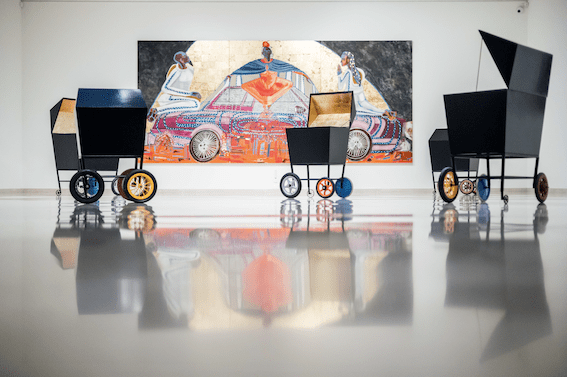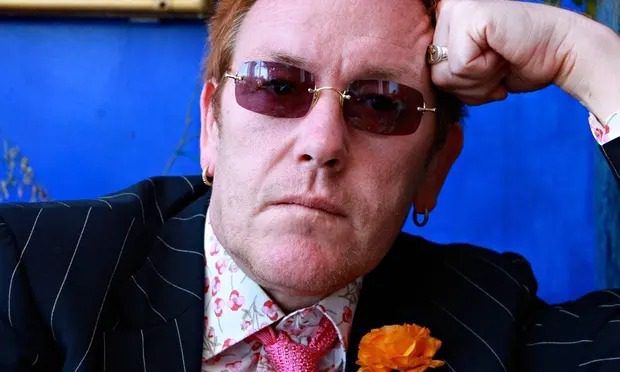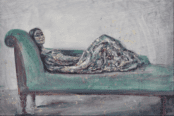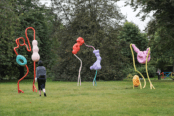“My best teacher was a dead teacher.”
— Ann Tracy
Influences, signs and symbols are writ large in the work of American artist Ann Tracy, whose show Transmissions is currently open at Impulse Gallery in Lucerne. The multi-disciplinary show features sculptural works, a collaborative work with poet Amy Hosing and contemporary classical composer Marcelo Toledo, centred around large-scale paintings reflecting the artist’s career trajectory from 2018 to the present day.
While studying sculpture at Boston University, Tracy began to explore figurative abstraction, drawing inspiration from both Phillip Guston (who taught at BU before she attended, hence the comment, “my best teacher was a dead teacher”), and also the early Renaissance painter, Piero Della Francesca. Both these influences loom large and collide in her works. Alongside the painterly influences are all the symbolic representations from her parallel lives as a teacher of Kundalini yoga and therapy. Each work is infused with ‘transmissions’; her term for the exchanges of knowledge and insight which occur in life, much as the transmission of a car regulates the power and movement of the vehicle. Through her paintings she highlights the ideas, energies and forces that come into our lives.

Key transmissions are drawn from her interest in spirituality, and mysticism, which anchor the various artistic disciplines she explores. The painter Wassily Kandinsky once said that, “every work of art is the child of its age”, and the large-scale works on display are deeply personal but address contemporary social, political and environmental challenges such as homelessness, AIDS, immigration, teenage runaways and ecological disaster; issues that the artist has long sought to address, not only through her artworks, but also through personal involvement in creative community projects aimed at addressing and highlighting social needs.
Central to this exhibit is a large-scale multi-panelled painting called Adrienne and the Twins, a portrait of a friend and her twin children, that echoes with all the interests of Tracy’s life. There is a huge nod to the work of Piero Dello Francesca, with the liberal use of gold leaf which grants the painting both a softness and quasi-religious, icon-like feel, even though the work itself echoes with more figuratively abstract forms. Egyptology, yogic chakras and other spiritual symbols inhabit this deeply personal work. Adrienne, who in this work substitutes for Virgin Mary featured in Dello Francesca’s work Polyptich of the Misericordia (1460-1462), sits on the roof a pink car, a 1979 Ford Thunderbird — the car which Tracy’s father drove in her childhood. While her father’s car was grey, this vehicle connects to the artist’s deep family ties and resonances. The car represents a time long gone, and the water flowing from the huge cape enveloping both Adrienne and the car symbolises both movement and the washing away of old ideas.

Throughout the paintings exhibited here, the idea of change is a constant, the cultural references and symbolism multiply as you move through the exhibit. The Poeta (She) Sizes Up the Jump, 2018, features a female figure squatting close to a ‘Guston-like’ motorcycle dressed in motorcycle gear reminiscent of the motorcycle daredevil, Evil Knievel. This figure, like Knievel, is also sizing up a canyon leap. The leap is onto what could be a ziggurat or a perhaps even a pile of books — a leap into new knowledge and away from old worlds. This is a key element throughout the works.
A series of works which Tracy calls night paintings are dotted throughout the gallery. Deep purples and bright, almost neon yellows and greens characterise these more reflective works. With titles like Night Time Garden and Dawn and Dusk in the Midnight Garden, it is no surprise that these works are filled with figures almost submerged in flowers and fauna. There are darker themes at work in some of these pieces, such as grief, loss and death, but the overall feeling is one of hope and possibility.
Later pieces introduce newer forms such as the animals, crystal-like forms and spaceships which inhabit a series of paintings called Galactic Diving 5 and 6 and Earth Ship. Spaceships feature predominantly in the later paintings, demonstrating an awareness of the growing cultural conversations and conspiracy theories which has emerged in the Internet era, and more recently with the release of U.S. government information via the Pentagon about UAP, or unidentified anomalous phenomena, the new term for UFOs. It is unclear from Tracy’s paintings whether the saucer-like alien spaceships are entering or leaving the Earth, a decision the artist lives to the viewer. In fact, most of Tracy’s works invite reflection on what is being conveyed, meaning is opaque and the paintings function like provocations, inviting audience participation and reflection on the themes contained in the works.

One wall of the gallery space is devoted to 40 small paintings of differing size and scale which reflect the artist’s most recent output. The number 40 has references across many spiritual traditions and was a key factor in the artist’s approach to these pieces. These wildly titled pieces feature some multiple recurring themes which cover a broad spectrum of human ideas and experiences, from bodily function in works such as Thyroid with Skin Frequency, and Liver with Pancreas Skin Frequency to galactic and alien interactions (Radiant Phenomena Landscape, Auric Camping Phenomena), along with automobiles, animals and architectural elements titled after religious works, such as Perugino Crocifissione Sant’ Augustino, 1506 with 166 Intercoupe. The marvellous titles of these paintings add to the content, set the mind thinking and invite a deeper engagement with what could be easily overlooked works, in that they lack the immediate impact of the large-scale pieces.
They Never Died—Seven Roses is a collaborative work that integrates poetry and music. The viewer is invited to sit in a small annex filled with an oversized armchair built by the artist and her husband. Once seated, words by the poet Amy Hosing supported by a musical composition from Marcelo Toledo invite quiet reflection. The volume is intentionally low in order to draw the listener’s ear away from external distraction. It’s surprisingly effective and moving. Opposite the annex is a wall featuring a small vessel which contains seven roses and seven small mirrors made of obsidian stone. Obsidian has long been considered a spiritual stone, believed to promote clarity, and release emotional and spiritual blockages, drawing out tensions and stress. The artist uses fabric and seating sparsely throughout the exhibit, believing that galleries often underestimate the role that comfortable seating can have in enabling deeper engagement with art. A giant, oversized armchair sits in one of the gallery rooms, its bold yellow fabric complementing and seamlessly extending the reach of the painting in front of which it sits.
The sculptural pieces are small, black, coffin-like boxes, painted gold on the inside and featuring tucked and buttoned velvet interiors — their purpose is enigmatic, they sit on found wheels, mostly from children’s pushchairs. They could be carriages or coffins, that is for the viewer to reflect on. They fill the main gallery space pushing the viewer to move amongst them in order to reach the paintings.
Impulse gallery is housed in what was once one of Lucerne’s most famous auction houses and comports itself perfectly as a gallery space. Marvellous light and bright airy rooms contribute to the vibrancy of these works by Ann Tracy. The gallery is a collaborative art space and some of the rooms feature other works that complement Tracy’s main exhibition both in terms of colour and feeling. This is a gallery committed to representing artists who engage with contemporary society and the challenges and opportunities it offers up, and Transmissions captures that spirit perfectly.
Transmissions by Ann Tracy
(17 October—21 December 2024)
Impulse Gallery
Haldenstrasse 19, 6006 Lucerne

Barry Taylor writes and speaks about the intersections of philosophy, theology and contemporary culture. In past, he was the road manager for AC/DC during the Bon Scott era before becoming a Los Angeles theologian.


















